
| 4 | |
| Helicobacter pylori 26695 | |
| chromosome [Browse all T4SS(s) in this replicon] | |
| NC_000915 | |
| 548134..579087 | |
| Cag | |
| effector translocation | |
| Type IVA; Type P | |
T4SS components |
| Component | CagC | CagD | CagE | CagF | CagG | CagH | CagI | CagL | CagN |
| Number | 1 | 1 | 1 | 1 | 1 | 1 | 1 | 1 | 1 |
| Component | CagM | CagT | CagU | CagV | CagW | CagX | CagY | CagZ | Cagalpha |
| Number | 1 | 1 | 1 | 1 | 1 | 1 | 1 | 1 | 1 |
| Component | Cagbeta | Caggamma | Cagdelta | ||||||
| Number | 1 | 1 | 1 |
The information of T4SS components from NC_000915 | ||||||
 | ||||||
| # | Locus tag (Gene) | Coordinates [+/-], size (bp) | Protein GI | Product | Component | |
| 1 | HP0517 (era) | 544336..545244 [+], 909 | 15645144 | GTP-binding protein Era | ||
| 2 | HP0518 | 545241..546233 [+], 993 | 15645145 | hypothetical protein | ||
| 3 | HP0519 | 546322..547152 [-], 831 | 15645146 | hypothetical protein | ||
| 4 | HP0520 | 547328..547675 [+], 348 | 15645147 | cag pathogenicity island protein (cag1) | ||
| 5 | HP0522 | 548134..549579 [+], 1446 | 15645148 | cag pathogenicity island protein (cag3) | Cagdelta | |
| 6 | HP0523 | 549589..550098 [+], 510 | 15645149 | cag pathogenicity island protein (cag4) | Caggamma | |
| 7 | HP0524 | 550217..552463 [-], 2247 | 15645150 | cag pathogenicity island protein (cag5) | Cagbeta | |
| 8 | HP0525 | 552472..553464 [-], 993 | 15645151 | virB11-like protein | Cagalpha | |
| 9 | HP0526 | 553469..554068 [-], 600 | 15645152 | cag pathogenicity island protein (cag6) | CagZ | |
| 10 | HP0527 | 554206..559989 [-], 5784 | 15645153 | cag pathogenicity island protein (cag7) | CagY | |
| 11 | HP0528 | 560004..561572 [-], 1569 | 15645154 | cag pathogenicity island protein (cag8) | CagX | |
| 12 | HP0529 | 561625..563232 [-], 1608 | 15645155 | cag pathogenicity island protein (cag9) | CagW | |
| 13 | HP0530 | 563237..563995 [-], 759 | 15645156 | cag pathogenicity island protein (cag10) | CagV | |
| 14 | HP0531 | 564381..565037 [+], 657 | 15645157 | cag pathogenicity island protein (cag11) | CagU | |
| 15 | HP0532 | 565073..565915 [+], 843 | 15645158 | cag pathogenicity island protein (cag12) | CagT | |
| 16 | HP0534 | 566126..566716 [-], 591 | 15645160 | cag pathogenicity island protein (cag13) | ||
| 17 | HP0535 | 567142..567522 [-], 381 | 15645161 | cag pathogenicity island protein (cag14) | ||
| 18 | HP0536 | 567955..568299 [-], 345 | 15645162 | cag pathogenicity island protein (cag15) | ||
| 19 | HP0537 | 568723..569853 [+], 1131 | 15645163 | cag pathogenicity island protein (cag16) | CagM | |
| 20 | HP0538 | 569868..570788 [+], 921 | 15645164 | cag pathogenicity island protein (cag17) | CagN | |
| 21 | HP0539 | 570870..571583 [-], 714 | 15645165 | cag pathogenicity island protein (cag18) | CagL | |
| 22 | HP0540 | 571580..572725 [-], 1146 | 15645166 | cag pathogenicity island protein (cag19) | CagI | |
| 23 | HP0541 | 572736..573848 [-], 1113 | 15645167 | cag pathogenicity island protein (cag20) | CagH | |
| 24 | HP0542 | 573864..574292 [-], 429 | 15645168 | cag pathogenicity island protein (cag21) | CagG | |
| 25 | HP0543 | 574347..575153 [-], 807 | 15645169 | cag pathogenicity island protein (cag22) | CagF | |
| 26 | HP0544 | 575155..578106 [-], 2952 | 15645170 | cag pathogenicity island protein (cag23) | CagE | |
| 27 | HP0545 | 578115..578738 [-], 624 | 15645171 | cag pathogenicity island protein (cag24) | CagD | |
| 28 | HP0546 | 578740..579087 [-], 348 | 15645172 | cag pathogenicity island protein (cag25) | CagC | |
| 29 | HP0547 | 579921..583481 [+], 3561 | 15645173 | cag pathogenicity island protein (cag26) | ||
Download FASTA format files |
| Proteins Genes |
| As a consequence of CagA action, epithelial cells will have some of their major functions disturbed, such as cell-cell adhesion, signalling, adherence and proliferation |
Effectors |
| CagA; Peptidoglycan |
The information of protein effectors | ||||||
| # | Locus tag (Gene) | Coordinates [+/-], size (bp) | Protein GI | Product | * | |
| 1 | HP0547 | 579921..583481 [+], 3561 | 15645173 | cag pathogenicity island protein (cag26) | ||
Download FASTA format files |
| Proteins Genes |
| # | Name | Image | Resource | Detail | Reference |
| 1 | CagA | 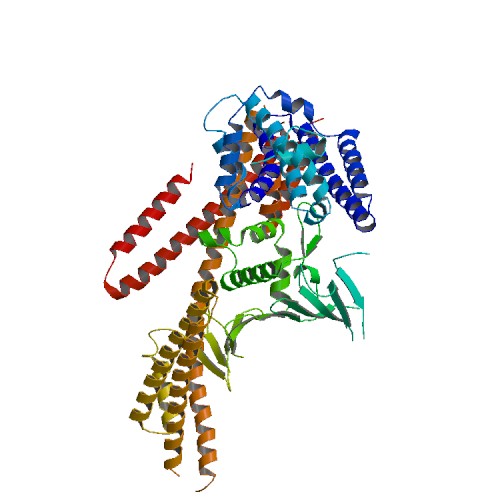 | PDB (4DVY) | Crystal structure of the Helicobacter pylori CagA oncoprotein. | (1) PubMed: 22817985 |
| 2 | CagA | 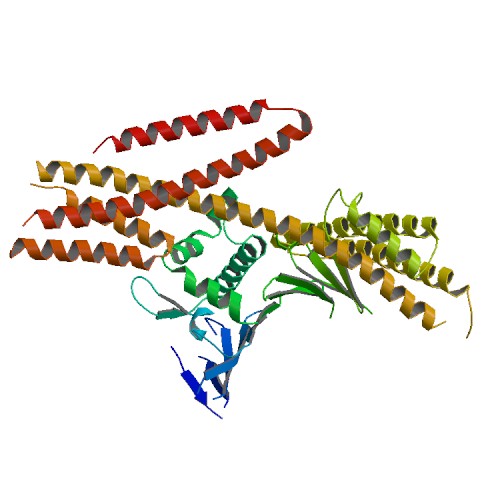 | PDB (4DVZ) | Crystal structure of the Helicobacter pylori CagA oncoprotein. | (2) PubMed: 22817985 |
| 3 | CagA Inhibits PAR1/MARK Family Kinases | 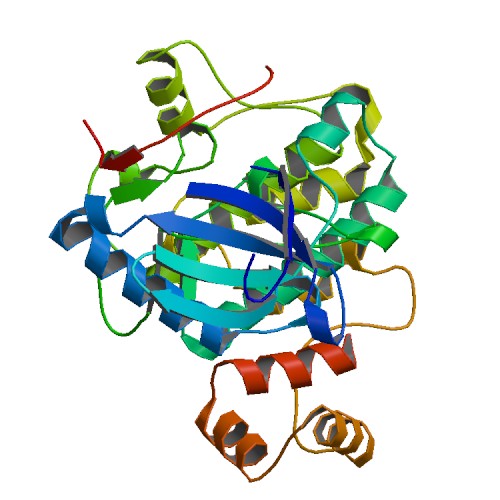 | PDB (3IEC) | Helicobacter pylori CagA Inhibits PAR1/MARK Family Kinases by Mimicking Host Substrates. | (3) PubMed: 19966800 |
| 4 | CagA Oncogene Bound to the Human Tumor Suppressor Apoptosis-stimulating Protein of p53-2 | 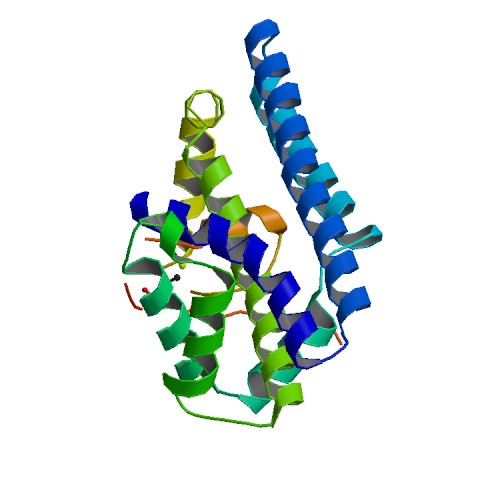 | PDB (4IRV) | Structure of the Helicobacter pylori CagA Oncogene Bound to the Human Tumor Suppressor Apoptosis-stimulating Protein of p53-2. | (4) PubMed: 24474782 |
| 5 | CagD |  | PDB (3CWX) | Crystal structure of cagd from helicobacter pylori pathogenicity island. | (5) PubMed: 19109970 |
| 6 | CagL | 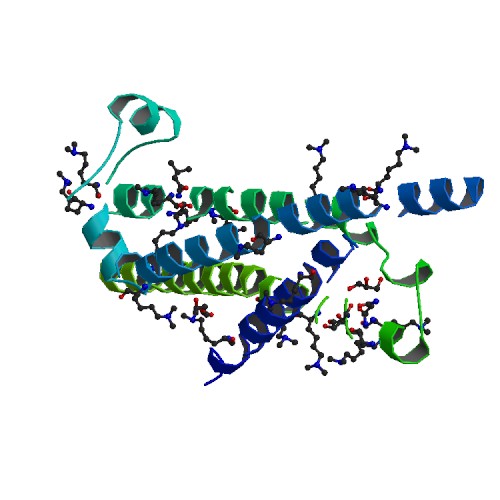 | PDB (3ZCJ) | Crystal structure of Helicobacter pylori T4SS protein CagL in a tetragonal crystal form with a helical RGD-motif (6 Mol per ASU). | (6) PubMed: 24076404 |
| 7 | CagL | 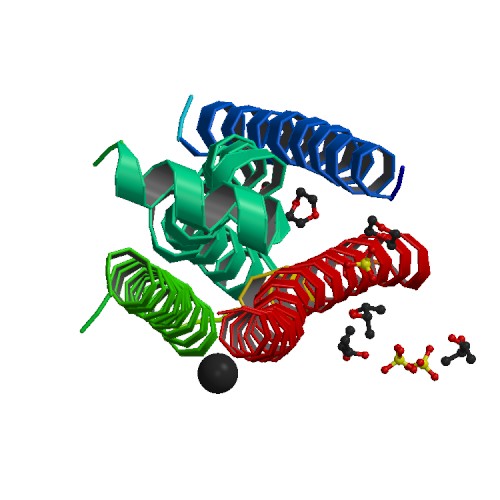 | PDB (3ZCI) | Crystal structure of Helicobacter pylori T4SS protein CagL in a cubic crystal form with a distorted helical conformation of the RGD-motif. | (7) PubMed: 24076404 |
| 8 | CagL | 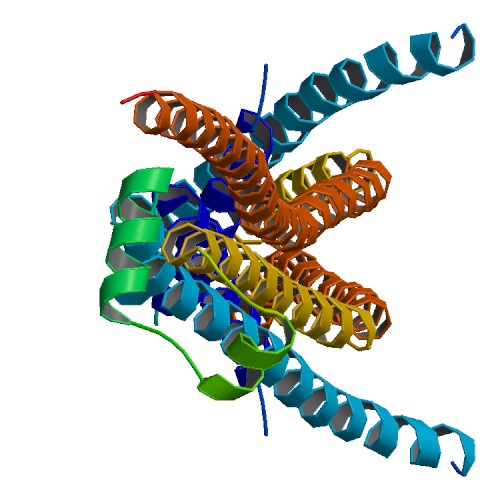 | PDB (4X5U) | X-ray crystal structure of CagL at pH 4.2. | (8) PubMed: 25837254 |
| 9 | CagS | 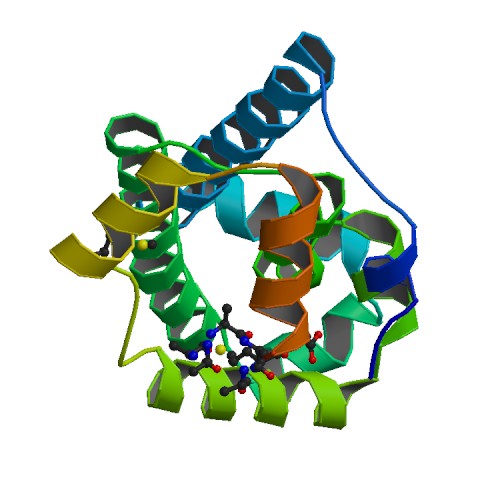 | PDB (2G3V) | Crystal structure of CagS (HP0534, Cag13) from Helicobacter pylori. | (9) PubMed: 17623849 |
| 10 | CagT | 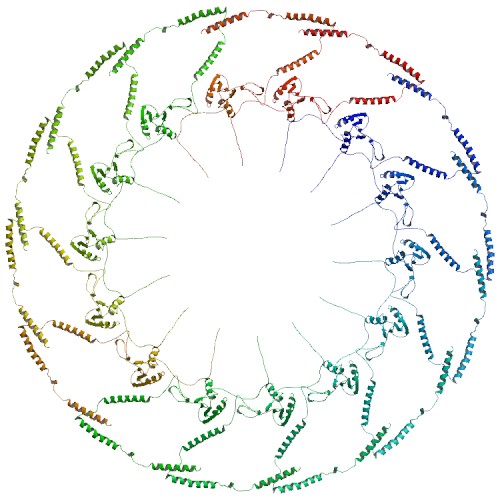 | PDB (6OEE) | Structure of CagT from a cryo-EM reconstruction of a T4SS. | (10) PubMed: 31210639 |
| 11 | Cag T4SS | 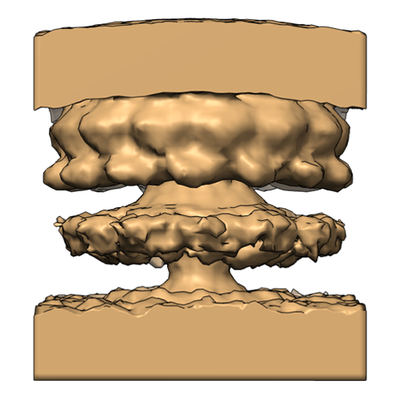 | EMDB(7474) | Subtomogram average of the cag type IV secretion system in Helicobacter pylori cells (aligning periplasmic parts). | (11) PubMed: 29669273 |
| 12 | CagX | 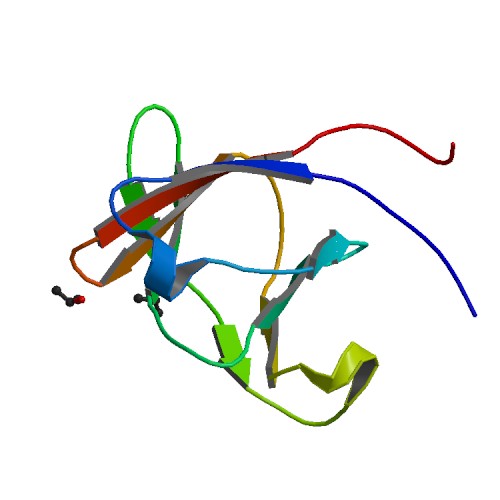 | PDB (5H3V) | Crystal structure of a Type IV Secretion System Component CagX in Helicobacter pylori. | (12) PubMed: 28291753 |
| 13 | CagX | 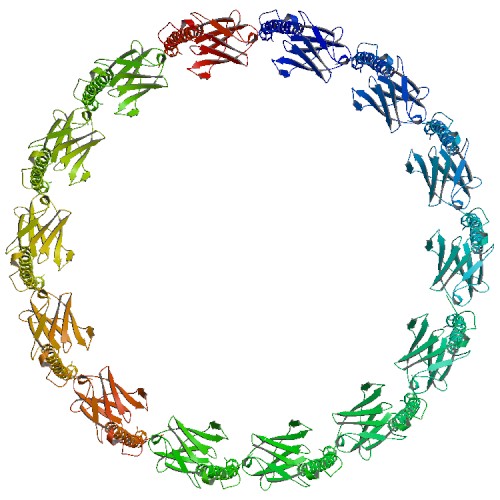 | PDB (6OEG) | Structure of CagX from a cryo-EM reconstruction of a T4SS | (13) PubMed: 31210639 |
| 14 | CagY | 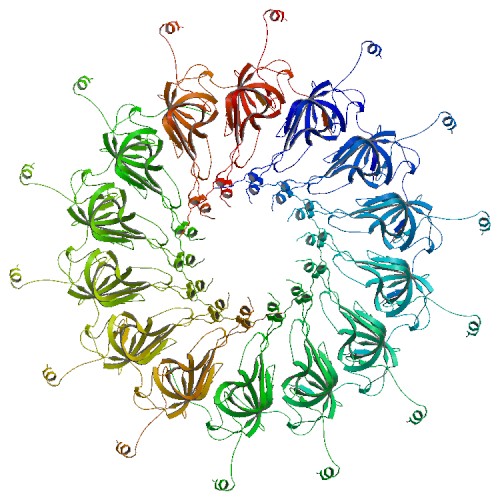 | PDB (6ODI) | Structure of CagY from a cryo-EM reconstruction of a T4SS. | (14) PubMed: 31210639 |
| 15 | CagY | 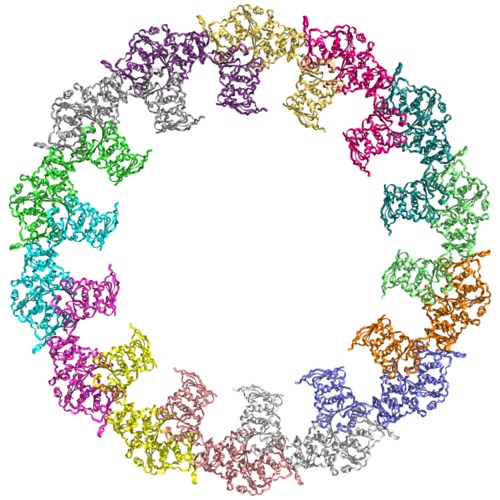 | PDB (6OEF) | Structure of CagY from a cryo-EM reconstruction of a T4SS. | (15) PubMed: 31210639 |
| 16 | CagZ | 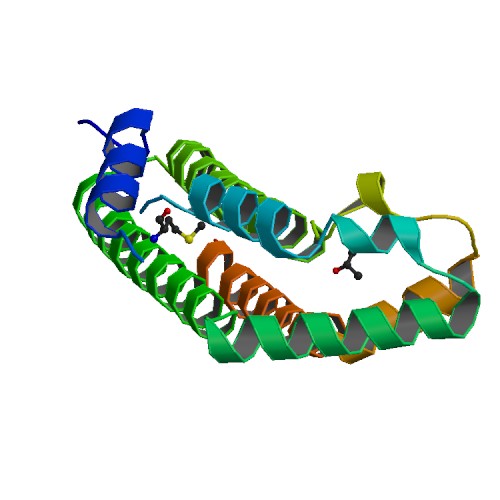 | PDB (1S2X) | Crystal structure of Cag-Z from Helicobacter pylori. | (16) PubMed: 15223328 |
| 17 | HP0525 | 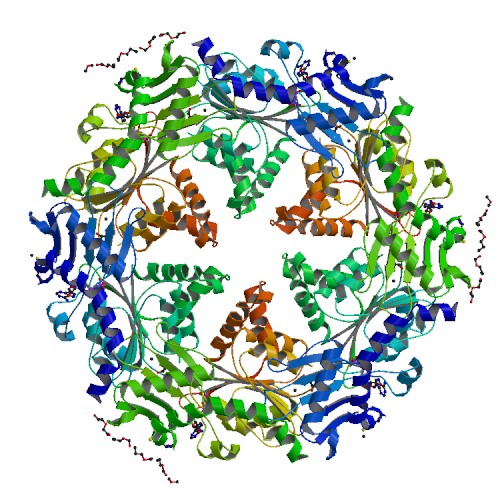 | PDB (1G6O) | Crystal structure of the helicobacter pylori ATPase, HP0525, in complex with ADP. | (17) PubMed: 11163218 |
| 18 | HP0525 bound by sulfate | 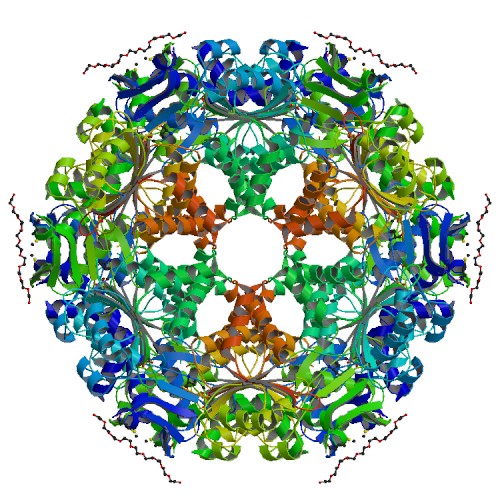 | PDB (1OPX) | Crystal structure of the traffic ATPase (HP0525) of the Helicobacter pylori type IV secretion system bound by sulfate. | (18) PubMed: 12727865 |
| 19 | N-terminal domain of CagA | 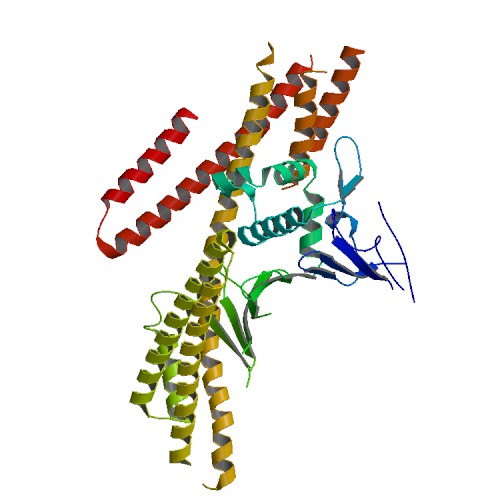 | PDB (4G0H) | Crystal structure of the N-terminal domain of Helicobacter pylori CagA protein. | (19) PubMed: 22908298 |
| 20 | Outer membrane core complex (OMCC) | 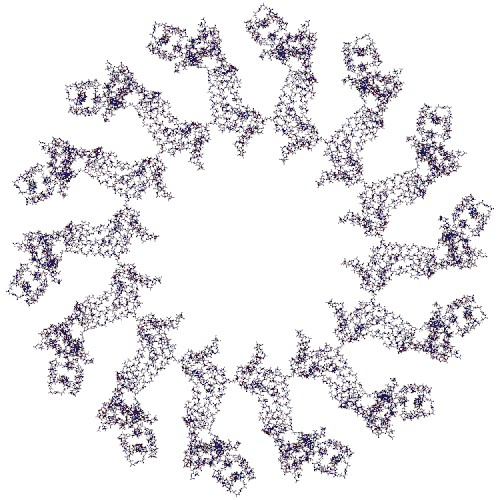 | PDB (6OEH) | PolyAla Model of OMCC I-Layer. | (20) PubMed: 31210639 |
| 21 | Outer membrane core complex (OMCC) |  | EMDB(20023) | Reconstruction of a T4SS OMCC. | (21) PubMed: 31210639 |
| 22 | Outer membrane core complex (OMCC) |  | EMDB(20020) | Reconstruction of a T4SS OMCC. | (22) PubMed: 31210639 |
| 23 | Outer membrane core complex (OMCC) |  | EMDB(20022) | Reconstruction of a T4SS OMCC. | (23) PubMed: 31210639 |
| 24 | Periplasmic ring complex (PRC) | 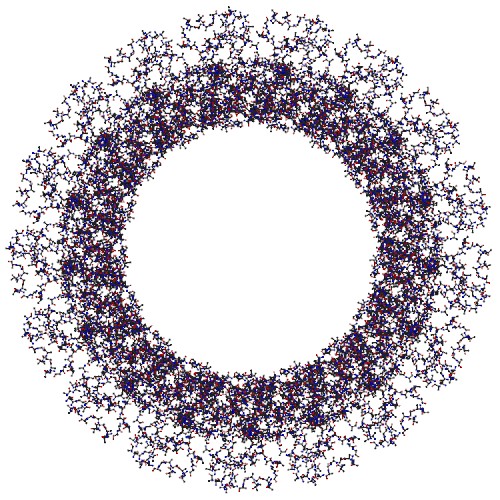 | PDB (6ODJ) | PolyAla Model of the PRC from the Type 4 Secretion System of H. pylori. | (24) PubMed: 31210639 |
| 25 | Periplasmic ring complex (PRC) |  | EMDB(20021) | PolyAla Model of the PRC from the Type 4 Secretion System of H. pylori. | (25) PubMed: 31210639 |
| 26 | VirB11 | PDB (1NLZ ) | Crystal structure of unliganded traffic ATPase of the type IV secretion system of helicobacter pylori. | (26) PubMed: 12727865 | |
| 27 | VirB11-like protein in complex with ATPgammaS | 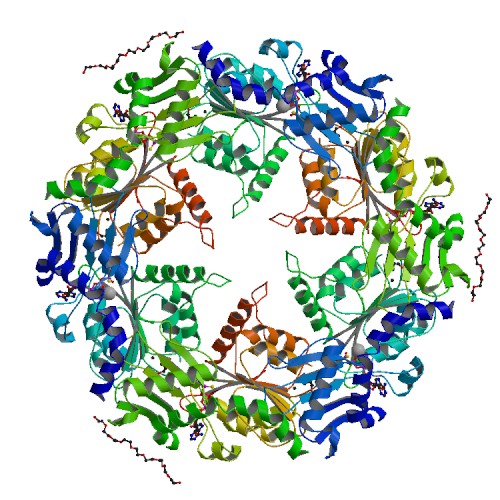 | PDB (1NLY) | Crystal structure of the traffic ATPase of the Helicobacter pylori type IV secretion system in complex with ATPgammaS. | (27) PubMed: 25825348 |
|
(1) Hayashi T et al. (2012). Tertiary structure-function analysis reveals the pathogenic signaling potentiation mechanism of Helicobacter pylori oncogenic effector CagA. Cell Host Microbe. 12(1):20-33. [PudMed:22817985] |
|
(2) Hayashi T et al. (2012). Tertiary structure-function analysis reveals the pathogenic signaling potentiation mechanism of Helicobacter pylori oncogenic effector CagA. Cell Host Microbe. 12(1):20-33. [PudMed:22817985] |
|
(3) Nesić D et al. (2010). Helicobacter pylori CagA inhibits PAR1-MARK family kinases by mimicking host substrates. Nat Struct Mol Biol. 17(1):130-2. [PudMed:19966800] |
|
(4) Nešić D et al. (2014). Structure of the Helicobacter pylori CagA oncoprotein bound to the human tumor suppressor ASPP2. Proc Natl Acad Sci U S A. 111(4):1562-7. [PudMed:24474782] |
|
(5) Cendron L; Couturier M; Angelini A; Barison N; Stein M; Zanotti G (2009). The Helicobacter pylori CagD (HP0545, Cag24) protein is essential for CagA translocation and maximal induction of interleukin-8 secretion. J Mol Biol. 386(1):204-17. [PudMed:19109970] |
|
(6) Barden S et al. (2013). A helical RGD motif promoting cell adhesion: crystal structures of the Helicobacter pylori type IV secretion system pilus protein CagL. Structure. 21(11):1931-41. [PudMed:24076404] |
|
(7) Barden S et al. (2013). A helical RGD motif promoting cell adhesion: crystal structures of the Helicobacter pylori type IV secretion system pilus protein CagL. Structure. 21(11):1931-41. [PudMed:24076404] |
|
(8) Bonsor DA et al. (2015). Integrin engagement by the helical RGD motif of the Helicobacter pylori CagL protein is regulated by pH-induced displacement of a neighboring helix. J Biol Chem. 290(20):12929-40. [PudMed:25837254] |
|
(9) Cendron L et al. (2007). The crystal structure of CagS from the Helicobacter pylori pathogenicity island. Proteins. 69(2):440-3. [PudMed:17623849] |
|
(10) Chung JM et al. (2019). Structure of the Helicobacter pylori Cag type IV secretion system. Elife. 8. pii: e47644. [PudMed:31210639] |
|
(11) Chang YW et al. (2018). In Vivo Structures of the Helicobacter pylori cag Type IV Secretion System. Cell Rep. 23(3):673-681. [PudMed:29669273] |
|
(12) Zhang J et al. (2017). Crystal structure of the type IV secretion system component CagX from Helicobacter pylori. Acta Crystallogr F Struct Biol Commun. 73(Pt 3):167-173. [PudMed:28291753] |
|
(13) Chung JM et al. (2019). Structure of the Helicobacter pylori Cag type IV secretion system. Elife. 8. pii: e47644. [PudMed:31210639] |
|
(14) Chung JM et al. (2019). Structure of the Helicobacter pylori Cag type IV secretion system. Elife. 8. pii: e47644. [PudMed:31210639] |
|
(15) Chung JM et al. (2019). Structure of the Helicobacter pylori Cag type IV secretion system. Elife. 8. pii: e47644. [PudMed:31210639] |
|
(16) Cendron L; Seydel A; Angelini A; Battistutta R; Zanotti G (2004). Crystal structure of CagZ, a protein from the Helicobacter pylori pathogenicity island that encodes for a type IV secretion system. J Mol Biol. 340(4):881-9. [PudMed:15223328] |
|
(17) Yeo HJ; Savvides SN; Herr AB; Lanka E; Waksman G (2000). Crystal structure of the hexameric traffic ATPase of the Helicobacter pylori type IV secretion system. Mol Cell. 6(6):1461-72. [PudMed:11163218] |
|
(18) Savvides SN; Yeo HJ; Beck MR; Blaesing F; Lurz R; Lanka E; Buhrdorf R; Fischer W; Haas R; Waksman G (2003). VirB11 ATPases are dynamic hexameric assemblies: new insights into bacterial type IV secretion. EMBO J. 22(9):1969-80. [PudMed:12727865] |
|
(19) Kaplan-Türköz B et al. (2012). Structural insights into Helicobacter pylori oncoprotein CagA interaction with β1 integrin. Proc Natl Acad Sci U S A. 109(36):14640-5. [PudMed:22908298] |
|
(20) Chung JM et al. (2019). Structure of the Helicobacter pylori Cag type IV secretion system. Elife. 8. pii: e47644. [PudMed:31210639] |
|
(21) Chung JM et al. (2019). Structure of the Helicobacter pylori Cag type IV secretion system. Elife. 8. pii: e47644. [PudMed:31210639] |
|
(22) Chung JM et al. (2019). Structure of the Helicobacter pylori Cag type IV secretion system. Elife. 8. pii: e47644. [PudMed:31210639] |
|
(23) Chung JM et al. (2019). Structure of the Helicobacter pylori Cag type IV secretion system. Elife. 8. pii: e47644. [PudMed:31210639] |
|
(24) Chung JM et al. (2019). Structure of the Helicobacter pylori Cag type IV secretion system. Elife. 8. pii: e47644. [PudMed:31210639] |
|
(25) Chung JM et al. (2019). Structure of the Helicobacter pylori Cag type IV secretion system. Elife. 8. pii: e47644. [PudMed:31210639] |
|
(26) Savvides SN; Yeo HJ; Beck MR; Blaesing F; Lurz R; Lanka E; Buhrdorf R; Fischer W; Haas R; Waksman G (2003). VirB11 ATPases are dynamic hexameric assemblies: new insights into bacterial type IV secretion. EMBO J. 22(9):1969-80. [PudMed:12727865] |
| (27) Ilangovan A et al. (2015). Structural biology of the Gram-negative bacterial conjugation systems. Trends Microbiol. 23(5):301-10. [PudMed:25825348] |
| # | Accessory protein(GI) | motif(s) | Substrate(s) | Function | Reference |
| 1 | CagF (chaperone) (15645169) | CT20aa and an intact N terminus | CagA | The CagA-binding protein CagF is a secretion chaperone-like protein that interacts with a region that is adjacent to the C-terminal secretion signal of CagA. | (1) PubMed: 17768234 |
|
(1) Pattis I; Weiss E; Laugks R; Haas R; Fischer W (2007). The Helicobacter pylori CagF protein is a type IV secretion chaperone-like molecule that binds close to the C-terminal secretion signal of the CagA effector protein. Microbiology. 153(Pt 9):2896-909. [PudMed:17768234] |
| # | Name(Protein GI) | Host site/Substrate | Source | Function | Reference | |
| 1 | CagA (15645173) | SHP-2 | human | CagA is translocated into gastric epithelial cells. It physically interacts with SHP-2 to modify cellular functions and perturb mammalian signal transduction machineries. This may induce gastric epithelial cells to move and proliferate abnormally and help to acquire a cellular transformed phenotype. | (1) PubMed: 11743164 | |
| 2 | CagA (15645173) | growth factor receptor bound 2 (Grb2) | unknown | CagA targets to Grb2 and this process leads to activing the MEK/ERK pathway and results in cell scattering and proliferation. | (2) PubMed: 12419219 | |
| 3 | CagA (15645173) | PAR1/MARK kinase | human | CagA interacts with PAR1/MARK kinase to inhibit the activity of PAR1 kinase and prevent PAR1 phosphorylation which mediated by atypical protein kinase C (aPKC). | (3) PubMed: 17507984 | |
| 4 | CagA (15645173) | Apoptosis-stimulating of p53 protein 2 (ASPP2) | human | ASPP2 is a tumor suppressor that activates the apoptotic response upon cellular stress which mediated by p53. CagA interacts with ASPP2 to change the function of ASPP2 and this process leads to the decreased survival of cells which infected by H. pylori. | (4) PubMed: 24474782 | |
| 5 | CagA (15645173) | protein kinase C-related kinase 2 (PRK2) | human | CagA represses kinase activity of PRK2, which has been involved in establishment of cell polarity and rearrangements of cytoskeleton, to further control signalling pathways associated with cancer. | (5) PubMed: 26041307 | |
| 6 | CagA (15645173) | Glycogen synthase kinase 3 (GSK-3) | human | CagA interacts with GSK-3 to reduce its activity by cause it to transform into an insoluble fraction. CagA then induce a epithelial mesenchymal transition mediated by Snail via the comsuming of GSK-3. | (6) PubMed: 25055241 | |
| 7 | CagA (15645173) | c-Met | human | CagA interacts with the c-Met receptor to modulates cellular functions through deregulating c-Met receptor signaling and participates in invasive growth of tumor cells. | (7) PubMed: 12719469 | |
| 8 | CagA (15645173) | E-cadherin | human | CagA interacts with E-cadherin to impair the complex formation between E-cadherin and beta-catenin and facilitate transdifferentiation of intestines in gastric epithelial cells. | (8) PubMed: 17237808 | |
| 9 | CagA (15645173) | host membrane phosphatidylserine | unknown | CagA can be tethered to the inner leaflet of the plasma membrane by interacting with phosphatidylserine. Then it binds the PAR1/MARK to induce polarity and junctional defects. | (9) PubMed: 20478541 | |
| 10 | CagA (15645173) | c-Abl tyrosine kinase | human | CagA targets to c-Abl directly and localizes in focal adhesion complexes and membrane ruffles. | (10) PubMed: 17160020 | |
| 11 | CagA (15645173) | αPix | human | CagA interacted with αPix to activates PAK1, ERK and NF-kappaB after being delivered into AGS cells. Then it induces the expression of IL-8 in infected gastric epithelial cells. | (11) PubMed: 19672789 | |
| 12 | CagA (15645173) | scaffolding protein ZO-1 | human, canine | CagA interacts with epithelial tight-junction ZO-1 and the transmembrane protein junctional adhesion molecule to change the function and composition of the apical-junctional complex. | (12) PubMed: 12775840 | |
| 13 | CagA (15645173) | integrin α5β1 receptor | human | CagA binds interface with α5β1 integrin.It is an essential step for the translocation process of CagA into the host cell. | (13) PubMed: 22908298 | |
| 14 | CagA (15645173) | TNF receptor-associated factor 1 and 4-1BB (TRAF1 and 4-1BB) | human | CagA facilitates the proliferation and represses the apoptosis of GES-1 cells by upregulated TRAF1/4-1BB. | (14) PubMed: 28627614 | |
| 15 | CagA (15645173) | Adapter molecule crk | human | The interaction between CagA and Crk adaptor proteins is important for loss of gastric epithelial cell adhesion induced by Helicobacter pylori-induced Helicobacter pylori. | (15) PubMed: 16275761 | |
| 16 | CagA (15645173) | SHP-1 | human | CagA interacts with SHP1 to enhance the phosphatase activity of SHP1 so that it dampens the oncogenic action of CagA. | (16) PubMed: 27572445 | |
| 17 | CagA (15645173) | Transforming growth factor-beta-activated kinase 1 (TAK1) | human | CagA interacts with TAK1 and improves its activity to activate NF-kappaB through the ubiquitination of TAK1. | (17) PubMed: 19820695 | |
| 18 | CagA (15645173) | Myeloid cell leukemia sequence-1 (MCL1) | mongolian gerbil | CagA increases MCL1 thorough the interaction between SRE/SRF and CagA/MCL1 in modulating rapid turnover of pit epithelial cells via MEK/ERK/SRE activation. | (18) PubMed: 18005743 | |
| 19 | CagL (15645165) | integrin α5β1 receptor | human | CagL, which is targeted to the pilus surface, is a specialized adhesin. It binds to and activates integrin α5β1 receptor on gastric epithelial cells. This interaction triggers CagA delivery into target cells. | (19) PubMed: 17943123 | |
| 20 | CagL (15645165) | integrin αvβ5 | human | CagL/integrin β5 signalling complex is important for gastrin expression induced by H. pylori. | (20) PubMed: 22287591 | |
| 21 | CagL (15645165) | integrin αvβ3 | human | Host cell docking of T4SS. | (21) PubMed: 21915696 | |
| 22 | CagL (15645165) | integrin αvβ6 | human | αvβ6 is a specific, high affinity receptor for CagL. | (22) PubMed: 31197920 | |
| 23 | CagY (15645153) | integrin α5β1 receptor | human | CagY interacts with α5β1 integrin, which acts like a molecular rheostat that modulates the host immune response to facilitate persistent infection. | (23) PubMed: 29764950 |
|
(1) Higashi H et al. (2002). SHP-2 tyrosine phosphatase as an intracellular target of Helicobacter pylori CagA protein. Science. 295(5555):683-6. [PudMed:11743164] |
|
(2) Mimuro H et al. (2002). Grb2 is a key mediator of helicobacter pylori CagA protein activities. Mol Cell. 10(4):745-55. [PudMed:12419219] |
|
(3) Saadat I et al. (2007). Helicobacter pylori CagA targets PAR1/MARK kinase to disrupt epithelial cell polarity. Nature. 447(7142):330-3. [PudMed:17507984] |
|
(4) Nešić D et al. (2014). Structure of the Helicobacter pylori CagA oncoprotein bound to the human tumor suppressor ASPP2. Proc Natl Acad Sci U S A. 111(4):1562-7. [PudMed:24474782] |
|
(5) Mishra JP et al. (2015). CagA of Helicobacter pylori interacts with and inhibits the serine-threonine kinase PRK2. Cell Microbiol. 17(11):1670-82. [PudMed:26041307] |
|
(6) Lee DG et al. (2014). Helicobacter pylori CagA promotes Snail-mediated epithelial-mesenchymal transition by reducing GSK-3 activity. Nat Commun. 5:4423. [PudMed:25055241] |
|
(7) Churin Y et al. (2003). Helicobacter pylori CagA protein targets the c-Met receptor and enhances the motogenic response. J Cell Biol. 161(2):249-55. [PudMed:12719469] |
|
(8) Murata-Kamiya N et al. (2007). Helicobacter pylori CagA interacts with E-cadherin and deregulates the beta-catenin signal that promotes intestinal transdifferentiation in gastric epithelial cells. Oncogene. 26(32):4617-26. [PudMed:17237808] |
|
(9) Murata-Kamiya N; Kikuchi K; Hayashi T; Higashi H; Hatakeyama M (2010). Helicobacter pylori exploits host membrane phosphatidylserine for delivery, localization, and pathophysiological action of the CagA oncoprotein. Cell Host Microbe. 7(5):399-411. [PudMed:20478541] |
|
(10) Poppe M; Feller SM; Romer G; Wessler S (2007). Phosphorylation of Helicobacter pylori CagA by c-Abl leads to cell motility. Oncogene. 26(24):3462-72. [PudMed:17160020] |
|
(11) Lim JW et al. (2009). alphaPix interacts with Helicobacter pylori CagA to induce IL-8 expression in gastric epithelial cells. Scand J Gastroenterol. 44(10):1166-72. [PudMed:19672789] |
|
(12) Amieva MR et al. (2003). Disruption of the epithelial apical-junctional complex by Helicobacter pylori CagA. Science. 300(5624):1430-4. [PudMed:12775840] |
|
(13) Kaplan-Türköz B et al. (2012). Structural insights into Helicobacter pylori oncoprotein CagA interaction with β1 integrin. Proc Natl Acad Sci U S A. 109(36):14640-5. [PudMed:22908298] |
|
(14) Wang F et al. (2017). CagA promotes proliferation and inhibits apoptosis of GES-1 cells by upregulating TRAF1/4-1BB. Mol Med Rep. 16(2):1262-1268. [PudMed:28627614] |
|
(15) Suzuki M et al. (2005). Interaction of CagA with Crk plays an important role in Helicobacter pylori-induced loss of gastric epithelial cell adhesion. J Exp Med. 202(9):1235-47. [PudMed:16275761] |
|
(16) Saju P et al. (2016). Host SHP1 phosphatase antagonizes Helicobacter pylori CagA and can be downregulated by Epstein-Barr virus. Nat Microbiol. 1:16026. [PudMed:27572445] |
|
(17) Lamb A et al. (2009). Helicobacter pylori CagA activates NF-kappaB by targeting TAK1 for TRAF6-mediated Lys 63 ubiquitination. EMBO Rep. 10(11):1242-9. [PudMed:19820695] |
|
(18) Mimuro H et al. (2007). Helicobacter pylori dampens gut epithelial self-renewal by inhibiting apoptosis, a bacterial strategy to enhance colonization of the stomach. Cell Host Microbe. 2(4):250-63. [PudMed:18005743] |
|
(19) Kwok T; Zabler D; Urman S; Rohde M; Hartig R; Wessler S; Misselwitz R; Berger J; Sewald N; Konig W; Backert S (2007). Helicobacter exploits integrin for type IV secretion and kinase activation. Nature. 449(7164):862-6. [PudMed:17943123] |
|
(20) Wiedemann T et al. (2012). Helicobacter pylori CagL dependent induction of gastrin expression via a novel αvβ5-integrin-integrin linked kinase signalling complex. Gut. 61(7):986-96. [PudMed:22287591] |
|
(21) Conradi J; Huber S; Gaus K; Mertink F; Royo Gracia S; Strijowski U; Backert S; Sewald N (2012). Cyclic RGD peptides interfere with binding of the Helicobacter pylori protein CagL to integrins alpha(V)beta (3) and alpha (5)beta (1). Amino Acids. 43(1):219-32. [PudMed:21915696] |
|
(22) Buß M et al. (2019). Specific high affinity interaction of Helicobacter pylori CagL with integrin αV β6 promotes type IV secretion of CagA into human cells. FEBS J. . [PudMed:31197920] |
|
(23) Skoog EC et al. (2018). CagY-Dependent Regulation of Type IV Secretion in Helicobacter pylori Is Associated with Alterations in Integrin Binding. MBio. 9(3). pii: e00717-18. [PudMed:29764950] |
| (1) Chandran Darbari V et al. (2015). Structural Biology of Bacterial Type IV Secretion Systems. Annu Rev Biochem. 84:603-29. [PudMed:26034891] |
|
(2) You Y; He L; Zhang M; Fu J; Gu Y; Zhang B; Tao X; Zhang J (2012). Comparative Genomics of Helicobacter pylori Strains of China Associated with Different Clinical Outcome. PLoS One. 7(6):e38528. [PudMed:22701658] |
|
(3) Jimenez-Soto LF; Rohrer S; Jain U; Ertl C; Sewald X; Haas R (2012). Effects of cholesterol on Helicobacter pylori growth and virulence properties in vitro. Helicobacter. 17(2):133-9. [PudMed:22404444] |
|
(4) Rizzato C; Torres J; Plummer M; Munoz N; Franceschi S; Camorlinga-Ponce M; Fuentes-Panana EM; Canzian F; Kato I (2012). Variations in Helicobacter pylori cytotoxin-associated genes and their influence in progression to gastric cancer: implications for prevention. PLoS One. 7(1):e29605. [PudMed:22235308] |
|
(5) Aviles-Jimenez F; Reyes-Leon A; Nieto-Patlan E; Hansen LM; Burgueno J; Ramos IP; Camorlinga-Ponce M; Bermudez H; Blancas JM; Cabrera L; Ribas-Aparicio RM; Solnick JV; Torres-Lopez J (2012). In vivo expression of Helicobacter pylori virulence genes in patients with gastritis, ulcer, and gastric cancer. Infect Immun. 80(2):594-601. [PudMed:22124657] |
|
(6) Lai CH; Wang HJ; Chang YC; Hsieh WC; Lin HJ; Tang CH; Sheu JJ; Lin CJ; Yang MS; Tseng SF; Wang WC (2011). Helicobacter pylori CagA-mediated IL-8 induction in gastric epithelial cells is cholesterol-dependent and requires the C-terminal tyrosine phosphorylation-containing domain. FEMS Microbiol Lett. 323(2):155-63. [PudMed:22092715] |
|
(7) Wang HJ; Cheng WC; Cheng HH; Lai CH; Wang WC (2012). Helicobacter pylori cholesteryl glucosides interfere with host membrane phase and affect type IV secretion system function during infection in AGS cells. Mol Microbiol. 83(1):67-84. [PudMed:22053852] |
| (8) Backert S; Clyne M; Tegtmeyer N (2011). Molecular mechanisms of gastric epithelial cell adhesion and injection of CagA by Helicobacter pylori. Cell Commun Signal. 9:28. [PudMed:22044679] |
|
(9) Mori N; Ishikawa C; Senba M (2011). Induction of CD69 expression by cagPAI-positive Helicobacter pylori infection. World J Gastroenterol. 17(32):3691-9. [PudMed:21990950] |
|
(10) Shaffer CL; Gaddy JA; Loh JT; Johnson EM; Hill S; Hennig EE; McClain MS; McDonald WH; Cover TL (2011). Helicobacter pylori exploits a unique repertoire of type IV secretion system components for pilus assembly at the bacteria-host cell interface. PLoS Pathog. 7(9):e1002237. [PudMed:21909278] |
| (11) Backert S; Clyne M (2011). Pathogenesis of Helicobacter pylori infection. Helicobacter. 16 Suppl 1:19-25. [PudMed:21896081] |
| (12) Terradot L; Waksman G (2011). Architecture of the Helicobacter pylori Cag-type IV secretion system. FEBS J. 278(8):1213-22. [PudMed:21352491] |
| (13) Tegtmeyer N; Backert S (2011). Role of Abl and Src family kinases in actin-cytoskeletal rearrangements induced by the Helicobacter pylori CagA protein. Eur J Cell Biol. 90(11):880-90. [PudMed:21247656] |
|
(14) Jurik A; Hausser E; Kutter S; Pattis I; Prassl S; Weiss E; Fischer W (2010). The coupling protein Cagbeta and its interaction partner CagZ are required for type IV secretion of the Helicobacter pylori CagA protein. Infect Immun. 78(12):5244-51. [PudMed:20876293] |
|
(15) Hutton ML; Kaparakis-Liaskos M; Turner L; Cardona A; Kwok T; Ferrero RL (2010). Helicobacter pylori exploits cholesterol-rich microdomains for induction of NF-kappaB-dependent responses and peptidoglycan delivery in epithelial cells. Infect Immun. 78(11):4523-31. [PudMed:20713621] |
|
(16) Tegtmeyer N; Hartig R; Delahay RM; Rohde M; Brandt S; Conradi J; Takahashi S; Smolka AJ; Sewald N; Backert S (2010). A small fibronectin-mimicking protein from bacteria induces cell spreading and focal adhesion formation. J Biol Chem. 285(30):23515-26. [PudMed:20507990] |
|
(17) Fischer W; Windhager L; Rohrer S; Zeiller M; Karnholz A; Hoffmann R; Zimmer R; Haas R (2010). Strain-specific genes of Helicobacter pylori: genome evolution driven by a novel type IV secretion system and genomic island transfer. Nucleic Acids Res. 38(18):6089-101. [PudMed:20478826] |
|
(18) Fehri LF; Rechner C; Janssen S; Mak TN; Holland C; Bartfeld S; Bruggemann H; Meyer TF (2009). Helicobacter pylori-induced modification of the histone H3 phosphorylation status in gastric epithelial cells reflects its impact on cell cycle regulation. Epigenetics. 4(8):577-86. [PudMed:20081355] |
|
(19) Brandt S; Kenny B; Rohde M; Martinez-Quiles N; Backert S (2009). Dual infection system identifies a crucial role for PKA-mediated serine phosphorylation of the EPEC-Tir-injected effector protein in regulating Rac1 function. Cell Microbiol. 11(8):1254-71. [PudMed:19438518] |
|
(20) Svensson H; Hansson M; Kilhamn J; Backert S; Quiding-Jarbrink M (2009). Selective upregulation of endothelial E-selectin in response to Helicobacter pylori-induced gastritis. Infect Immun. 77(7):3109-16. [PudMed:19414551] |
|
(21) Tegtmeyer N; Zabler D; Schmidt D; Hartig R; Brandt S; Backert S (2009). Importance of EGF receptor, HER2/Neu and Erk1/2 kinase signalling for host cell elongation and scattering induced by the Helicobacter pylori CagA protein: antagonistic effects of the vacuolating cytotoxin VacA. Cell Microbiol. 11(3):488-505. [PudMed:19046339] |
| (22) Hatakeyama M (2008). Linking epithelial polarity and carcinogenesis by multitasking Helicobacter pylori virulence factor CagA. Oncogene. 27(55):7047-54. [PudMed:19029944] |
|
(23) Kutter S; Buhrdorf R; Haas J; Schneider-Brachert W; Haas R; Fischer W (2008). Protein subassemblies of the Helicobacter pylori Cag type IV secretion system revealed by localization and interaction studies. J Bacteriol. 190(6):2161-71. [PudMed:18178731] |
|
(24) Minohara Y; Boyd DK; Hawkins HK; Ernst PB; Patel J; Crowe SE (2007). The effect of the cag pathogenicity island on binding of Helicobacter pylori to gastric epithelial cells and the subsequent induction of apoptosis. Helicobacter. 12(6):583-90. [PudMed:18001397] |
|
(25) Pattis I; Weiss E; Laugks R; Haas R; Fischer W (2007). The Helicobacter pylori CagF protein is a type IV secretion chaperone-like molecule that binds close to the C-terminal secretion signal of the CagA effector protein. Microbiology. 153(Pt 9):2896-909. [PudMed:17768234] |
|
(26) Poppe M; Feller SM; Romer G; Wessler S (2007). Phosphorylation of Helicobacter pylori CagA by c-Abl leads to cell motility. Oncogene. 26(24):3462-72. [PudMed:17160020] |
|
(27) Oyarzabal OA; Rad R; Backert S (2007). Conjugative transfer of chromosomally encoded antibiotic resistance from Helicobacter pylori to Campylobacter jejuni. J Clin Microbiol. 45(2):402-8. [PudMed:17135441] |
|
(28) Oliveira MJ; Costa AC; Costa AM; Henriques L; Suriano G; Atherton JC; Machado JC; Carneiro F; Seruca R; Mareel M; Leroy A; Figueiredo C (2006). Helicobacter pylori induces gastric epithelial cell invasion in a c-Met and type IV secretion system-dependent manner. J Biol Chem. 281(46):34888-96. [PudMed:16990273] |
|
(29) Andrzejewska J; Lee SK; Olbermann P; Lotzing N; Katzowitsch E; Linz B; Achtman M; Kado CI; Suerbaum S; Josenhans C (2006). Characterization of the pilin ortholog of the Helicobacter pylori type IV cag pathogenicity apparatus, a surface-associated protein expressed during infection. J Bacteriol. 188(16):5865-77. [PudMed:16885455] |
|
(30) Busler VJ; Torres VJ; McClain MS; Tirado O; Friedman DB; Cover TL (2006). Protein-protein interactions among Helicobacter pylori cag proteins. J Bacteriol. 188(13):4787-800. [PudMed:16788188] |
|
(31) Hohlfeld S; Pattis I; Puls J; Plano GV; Haas R; Fischer W (2006). A C-terminal translocation signal is necessary, but not sufficient for type IV secretion of the Helicobacter pylori CagA protein. Mol Microbiol. 59(5):1624-37. [PudMed:16469000] |
|
(32) Krueger S; Hundertmark T; Kalinski T; Peitz U; Wex T; Malfertheiner P; Naumann M; Roessner A (2006). Helicobacter pylori encoding the pathogenicity island activates matrix metalloproteinase 1 in gastric epithelial cells via JNK and ERK. J Biol Chem. 281(5):2868-75. [PudMed:16321971] |
|
(33) Backert S; Kwok T; Konig W (2005). Conjugative plasmid DNA transfer in Helicobacter pylori mediated by chromosomally encoded relaxase and TraG-like proteins. Microbiology. 151(Pt 11):3493-503. [PudMed:16272373] |
|
(34) Zahrl D; Wagner M; Bischof K; Bayer M; Zavecz B; Beranek A; Ruckenstuhl C; Zarfel GE; Koraimann G (2005). Peptidoglycan degradation by specialized lytic transglycosylases associated with type III and type IV secretion systems. Microbiology. 151(Pt 11):3455-67. [PudMed:16272370] |
|
(35) Backert S; Gressmann H; Kwok T; Zimny-Arndt U; Konig W; Jungblut PR; Meyer TF (2005). Gene expression and protein profiling of AGS gastric epithelial cells upon infection with Helicobacter pylori. Proteomics. 5(15):3902-18. [PudMed:16145711] |
|
(36) Bauer B; Moese S; Bartfeld S; Meyer TF; Selbach M (2005). Analysis of cell type-specific responses mediated by the type IV secretion system of Helicobacter pylori. Infect Immun. 73(8):4643-52. [PudMed:16040977] |
|
(37) Viala J; Chaput C; Boneca IG; Cardona A; Girardin SE; Moran AP; Athman R; Memet S; Huerre MR; Coyle AJ; DiStefano PS; Sansonetti PJ; Labigne A; Bertin J; Philpott DJ; Ferrero RL (2004). Nod1 responds to peptidoglycan delivered by the Helicobacter pylori cag pathogenicity island. Nat Immunol. 5(11):1166-74. [PudMed:15489856] |
|
(38) Selbach M; Moese S; Backert S; Jungblut PR; Meyer TF (2004). The Helicobacter pylori CagA protein induces tyrosine dephosphorylation of ezrin. Proteomics. 4(10):2961-8. [PudMed:15378755] |
|
(39) Al-Ghoul L; Wessler S; Hundertmark T; Kruger S; Fischer W; Wunder C; Haas R; Roessner A; Naumann M (2004). Analysis of the type IV secretion system-dependent cell motility of Helicobacter pylori-infected epithelial cells. Biochem Biophys Res Commun. 322(3):860-6. [PudMed:15336542] |
|
(40) Aras RA; Fischer W; Perez-Perez GI; Crosatti M; Ando T; Haas R; Blaser MJ (2003). Plasticity of repetitive DNA sequences within a bacterial (Type IV) secretion system component. J Exp Med. 198(9):1349-60. [PudMed:14581606] |
|
(41) Buhrdorf R; Forster C; Haas R; Fischer W (2003). Topological analysis of a putative virB8 homologue essential for the cag type IV secretion system in Helicobacter pylori. Int J Med Microbiol. 293(2-3):213-7. [PudMed:12868658] |
|
(42) Rohde M; Puls J; Buhrdorf R; Fischer W; Haas R (2003). A novel sheathed surface organelle of the Helicobacter pylori cag type IV secretion system. Mol Microbiol. 49(1):219-34. [PudMed:12823823] |
|
(43) Tanaka J; Suzuki T; Mimuro H; Sasakawa C (2003). Structural definition on the surface of Helicobacter pylori type IV secretion apparatus. Cell Microbiol. 5(6):395-404. [PudMed:12780777] |
|
(44) Savvides SN; Yeo HJ; Beck MR; Blaesing F; Lurz R; Lanka E; Buhrdorf R; Fischer W; Haas R; Waksman G (2003). VirB11 ATPases are dynamic hexameric assemblies: new insights into bacterial type IV secretion. EMBO J. 22(9):1969-80. [PudMed:12727865] |
|
(45) Backert S; Churin Y; Meyer TF (2002). Helicobacter pylori type IV secretion, host cell signalling and vaccine development. Keio J Med. 51 Suppl 2:6-14. [PudMed:12528929] |
|
(46) Schroder G; Krause S; Zechner EL; Traxler B; Yeo HJ; Lurz R; Waksman G; Lanka E (2002). TraG-like proteins of DNA transfer systems and of the Helicobacter pylori type IV secretion system: inner membrane gate for exported substrates. J Bacteriol. 184(10):2767-79. [PudMed:11976307] |
|
(47) Fischer W; Puls J; Buhrdorf R; Gebert B; Odenbreit S; Haas R (2001). Systematic mutagenesis of the Helicobacter pylori cag pathogenicity island: essential genes for CagA translocation in host cells and induction of interleukin-8. Mol Microbiol. 42(5):1337-48. [PudMed:11886563] |
|
(48) Selbach M; Moese S; Meyer TF; Backert S (2002). Functional analysis of the Helicobacter pylori cag pathogenicity island reveals both VirD4-CagA-dependent and VirD4-CagA-independent mechanisms. Infect Immun. 70(2):665-71. [PudMed:11796597] |
|
(49) Churin Y; Kardalinou E; Meyer TF; Naumann M (2001). Pathogenicity island-dependent activation of Rho GTPases Rac1 and Cdc42 in Helicobacter pylori infection. Mol Microbiol. 40(4):815-23. [PudMed:11401689] |
|
(50) Backert S; Ziska E; Brinkmann V; Zimny-Arndt U; Fauconnier A; Jungblut PR; Naumann M; Meyer TF (2000). Translocation of the Helicobacter pylori CagA protein in gastric epithelial cells by a type IV secretion apparatus. Cell Microbiol. 2(2):155-64. [PudMed:11207572] |
|
(51) Ramarao N; Gray-Owen SD; Backert S; Meyer TF (2000). Helicobacter pylori inhibits phagocytosis by professional phagocytes involving type IV secretion components. Mol Microbiol. 37(6):1389-404. [PudMed:10998171] |